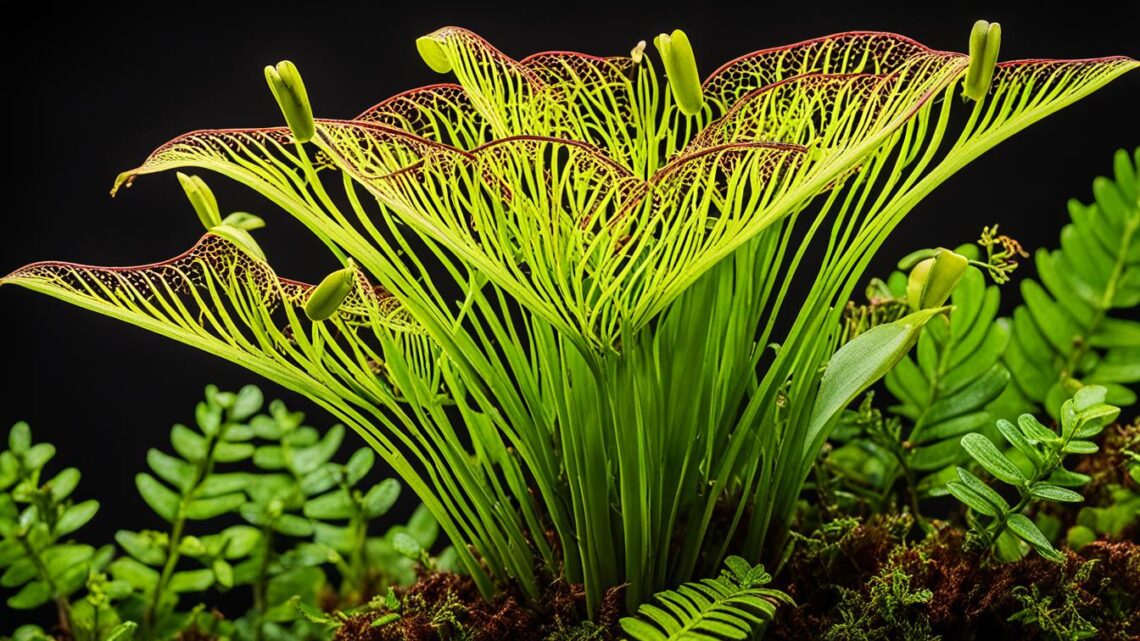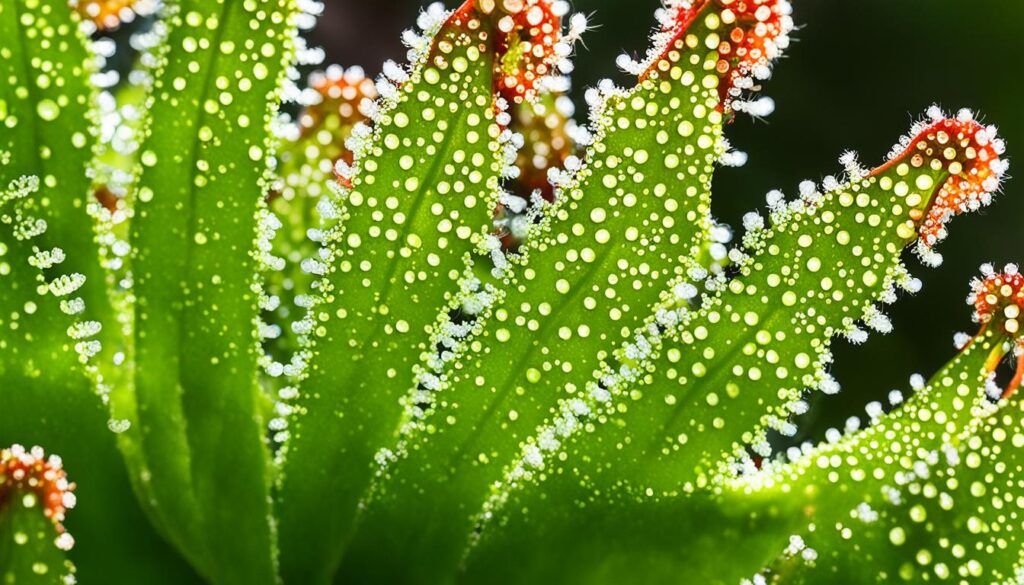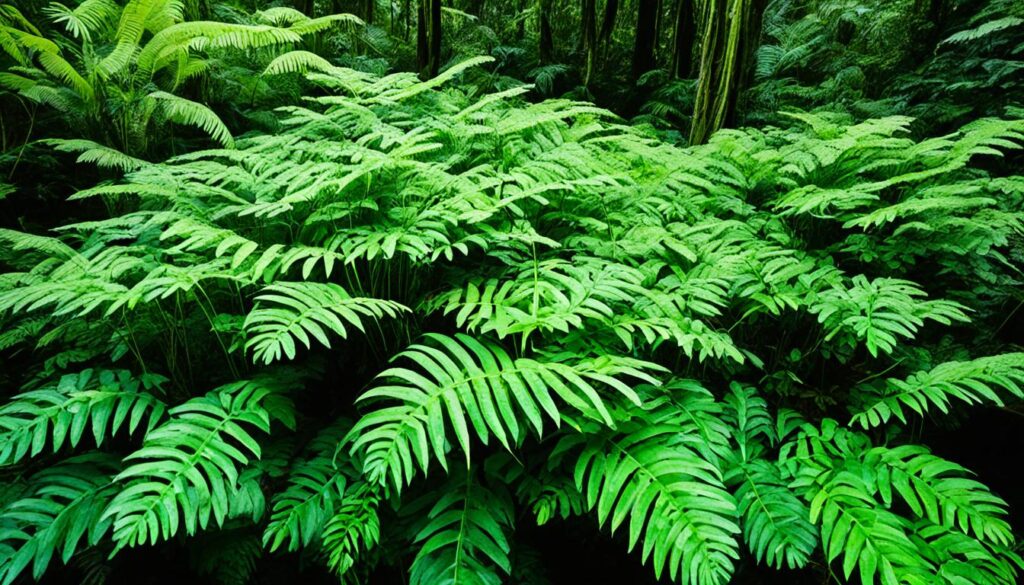
Have you heard of the umbrella plant, Triphyophyllum peltatum? It’s a rare yet fascinating plant from Madagascar’s rainforests. This plant is unique among carnivorous plants, making it a special choice for those who love plants.
Triphyophyllum peltatum is easy to care for indoors. It does well in low-light areas. Plus, it thrives in places with lots of moisture. This makes it perfect for someone wanting an interesting but simple plant.
So, what’s special about this umbrella plant? How does it live in poor nutrient areas? Let’s explore Triphyophyllum peltatum’s incredible story of how it became a plant that eats meat.
Uncovering the Mysterious World of Carnivorous Plants
Carnivorous plants fascinate both scientists and nature lovers. They grow in places with little soil nutrients. To solve this, they catch and eat insects for vital nutrients.
The Bizarre Adaptations of Nutrient-Deprived Environments
These plants live in areas with poor soil nutrients. They get sugars through photosynthesis like plants do. But, they also get essential nutrients by hunting and eating bugs and sometimes even small animals.
New studies look at how these plants hunt as a smart strategy. Instead of just waiting for food, they actively catch it. This is changing how we see these plants and their important place in nature.
Exploring the Diverse Trapping Mechanisms
- Pitfall Traps: Plants like the Nepenthes have pitcher-shaped traps. These traps have liquid inside to catch their prey.
- Flypaper Traps: Sundews and butterworts have sticky leaves. Insects get stuck in the sticky dew and can’t get out.
- Snap Traps: The Venus flytrap is famous for its quick-closing leaves. When an insect touches it, the plant snaps shut.
- Suction Traps: Bladderworts live in water or damp soil. They have tiny suction traps that quickly suck in their prey.
- Lobster-Pot Traps: Plants like certain Nepenthes have clever tubes. Prey can enter but can’t leave, a bit like a lobster pot.
These trapping methods show how amazing carnivorous plants are. They’ve evolved unique ways to get food in tough places.

Triphyophyllum peltatum: The Umbrella Plant’s Carnivorous Nature
In Madagascar’s rainforests, you’ll find the amazing Triphyophyllum peltatum. This is also called the umbrella plant. It’s really good at living in places where nutrients are scarce. It catches and eats small animals to get the nutrients it needs.
This plant is lonely in its genus, which means it has no company except for itself. It’s from tropical western Africa, living in places like Ivory Coast and Liberia. It goes through three distinct stages where its leaves look different.
The umbrella plant is huge. It’s actually the biggest known carnivorous plant in the world. In its liana form, it can grow up to 165 feet long and is about four inches thick. The fact that it can grow so big shows how well it adapts to its environment.

In 1979, we found out that the umbrella plant eats animals. This was 51 years after we first learned about this special plant. Its bright red, disc-shaped seeds are about 3 inches wide. They really add to the plant’s mysterious appeal.
Even though it’s very rare, the umbrella plant is looked after in a few places like Abidjan and Bonn. Places like Cambridge University and Würzburg also take care of it. Researchers and people who love plants are really interested in it because of its unique traits and what it might offer medicine.
The Evolution of Carnivory: A Convergent Tale
Plants have a special skill called carnivory. This is the ability to catch and eat animals. It has happened several times in the history of plants. This is called convergent evolution. It led to the creation of many different ways to trap and eat prey.
In some plant families, like Sarraceniaceae and Nepenthaceae, you can see a cool example. These plants have slippery pools of liquid to catch bugs. This lets them get important nutrients like nitrogen and phosphorus from their prey.
Pitfall Traps: Nature’s Slippery Pools
Pitfall traps look like cups on these plants. Bugs and small creatures get attracted to them and fall in. There, the prey can’t get out because the inside is very slippery. They become food for the plant.
- Carnivory has evolved independently at least six times in five angiosperm orders, according to scientific research.
- Genera with morphologically complex traps, such as pitcher plants, have higher relative rates of gene substitutions compared to those with simple sticky traps.
- The energetics hypothesis, which suggests that carnivory evolved to supplement nutrient deficiencies, is more supported than the predictable prey capture hypothesis in the evolution of carnivorous plant lineages.
The way carnivorous plants have evolved is super interesting. It shows just how creative life can be. It also shows the complex ways plants and animals interact with their surroundings. Studying how plants like pitcher plants have developed helps us learn more about nature’s ongoing changes.
Flypaper Traps: Sticky Sentinels of the Plant Kingdom
In the world of carnivorous plants, flypaper traps are amazing. They use sticky mucilage to catch bugs. Butterworts and sundews are two types that do this best.
Sundews and Butterworts: Masters of Mucilage
Sundews have leaves that look like tentacles. They can make a lot of sticky stuff. This goo makes a perfect trap for insects.
Butterworts use a similar idea. Their leaves have tiny hairs that produce a sticky liquid. Bugs walking on them get caught.
These plants have evolved special ways to catch food and grow in hard places. Their traps are very efficient.
| Flypaper Trap Characteristics | Sundews (Drosera) | Butterworts (Pinguicula) |
|---|---|---|
| Leaf Surface | Covered in tentacle-like glandular hairs | Coated in tiny glandular hairs |
| Secreted Mucilage | Copious amounts of adhesive mucilage | Viscous, lubricating mucilage |
| Trapping Mechanism | Insects become ensnared in the sticky tentacles | Insects become entangled in the sticky surface |
The sundew and butterwort traps show how smart plants can be. They use stickiness to catch food. This trick lets them survive where there’s not much food.
Snap Traps: Nature’s Steel Jaws
In the world of meat-eating plants, some have developed an amazing way to catch food. It’s called the snap trap. This cool trick lets plants quickly shut their leaves to trap bugs. The Venus flytrap (Dionaea muscipula) is the most famous example. It amazes both plant fans and scientists.
The Venus flytrap isn’t the only one that catches its meals this way. There’s also the waterwheel plant (Aldrovanda vesiculosa). It catches tiny water bugs using a snap trap. This shows how diverse and clever carnivorous plants can be.
The snap trap works thanks to special cells. These cells sense when a bug is walking on the plant. Then, they send out a quick signal. This causes the trap to close in less than a second, trapping the bug inside.
The snap trap shows just how amazing nature is. These plants live in places with not much food. So, they catch and eat bugs. This strategy shows the incredible ways plants can change to survive.
Suction Traps: Vacuum-Powered Predators
Carnivorous plants come in many types beyond the usual pitfall and flypaper traps. The suction trap, or bladder trap, is an amazing example. It’s found in plants like Utricularia, known as bladderworts. These plants live in water and use a special vacuum power to catch and eat small water creatures.
Bladderworts: Underwater Hunters
Bladderworts are special because they live in places with little food in the water. They have tiny traps called bladders. When something touches these bladders, they quickly suck in the creature. This lets the plant get the nutrients it needs from the creatures it catches.
- Bladderworts are found in a wide range of aquatic environments, including ponds, lakes, and even bogs.
- Their bladder traps are incredibly efficient, capable of capturing a variety of small aquatic organisms, including Daphnia, mosquito larvae, and even small fish.
- The trigger mechanism of the bladder trap is highly sensitive, allowing the plant to react quickly to the presence of potential prey.
- Once the trap is triggered, the bladder can reopen and reset itself within just a few minutes, ready to capture the next unsuspecting victim.
The development of suction traps in bladderworts shows a smart strategy. By using vacuum suction, these plants get food and live better in places with few nutrients. They’re able to get what they need and grow better than plants that don’t eat insects.
Lobster-Pot Traps: Twisted Tubes of Carnivorous Cunning
The lobster-pot trap, also known as an eel trap, is a unique catching method in Genlisea plants. These plants, called corkscrew plants, use a twisted tube to catch and eat their prey. This method involves a structure with hairs and glands that attract, then trap, small animals.
This trapping strategy is a product of evolution in the Genlisea genus of plants. It helps them live in places with poor nutrients. The special trap is a long, thin tube. It has hairs that point inward, guiding prey inside for digestion.
Prey caught by these plants finds it hard to leave. The trap’s walls have glands that make enzymes. These enzymes dissolve the prey into food that the plant uses to grow.
| Trapping Mechanism | Prey Attraction | Prey Capture | Prey Digestion |
|---|---|---|---|
| Twisted tubular structure | Hairy, glandular inner walls | Inward-pointing hairs guide prey deep into the trap | Digestive enzymes secreted by glands on the inner walls |
The corkscrew plants have become top hunters with their lobster-pot traps. These plants are a great example of how life can be successful in tough spots. Their fascinating traps show the many clever ways plants can catch food, drawing the interest of scientists and fans.
Conservation Challenges: Protecting Nature’s Curiosities
Carnivorous plants are fascinating but face big risks. Destruction of their homes and too much collecting are problems. These plants are often rare, found in special places that are easy to damage.
To save these unusual plants is important. They’ve evolved to live in places where food is scarce. Guarding their homes and limiting how many are taken is key for their survival.
Take the Venus Flytrap, for example. It’s lost 93% of its living space since 1979. There may not be many places left for it in the next hundred years. The plant’s way of life is fragile, with seeds that don’t grow easily and traps that only work a few times.
| Threat | Impact | Conservation Efforts |
|---|---|---|
| Habitat Destruction | Carnivorous plants rely on specific, fragile environments that are vulnerable to human activities like development, agriculture, and resource extraction. | Protecting and restoring natural habitats, creating conservation areas, and promoting sustainable land-use practices. |
| Over-Collection | The popularity of carnivorous plants as ornamental and novelty items has led to unsustainable collection from the wild, depleting natural populations. | Enforcing regulations on wild collection, promoting captive propagation, and educating the public on responsible plant ownership. |
There’s good news: new state laws are making it harder to harm these plants. And poachers are now being caught. With more work and study, there’s hope for keeping these wonders alive.
Unraveling the Mysteries: Ongoing Research in Carnivorous Plants
The story of carnivorous plants captivates biologists and researchers alike. They’re exploring the convergent evolution of trap styles and unique plant adaptations. This includes finding new species in their ongoing research.
In looking at carnivorous plant evolution, the focus is on their ability to grow in places lacking nutrients. By taking apart the plants’ special parts, like traps, their secrets are slowly being uncovered. For instance, studies by Takahara and Takács show how these plants adapt and thrive.
Researchers are also keen on the many types of carnivorous plants out there. Takahashi et al. looked at a fern’s leaf development in 2015, adding to our knowledge. And thanks to Takhtajan’s hard work in the 70s and 80s, we understand more about fossil plants. This includes details about Magnoliaceae and Betulaceae families. His ideas about flower plants’ beginnings, like neoteny, have also helped shape our plant evolution knowledge.



